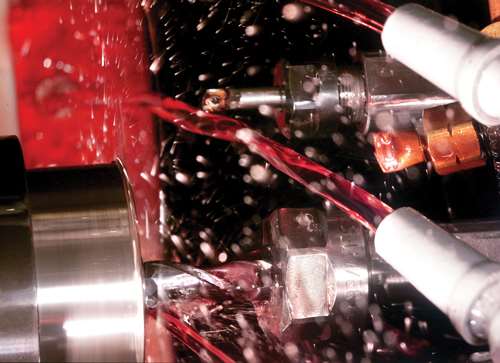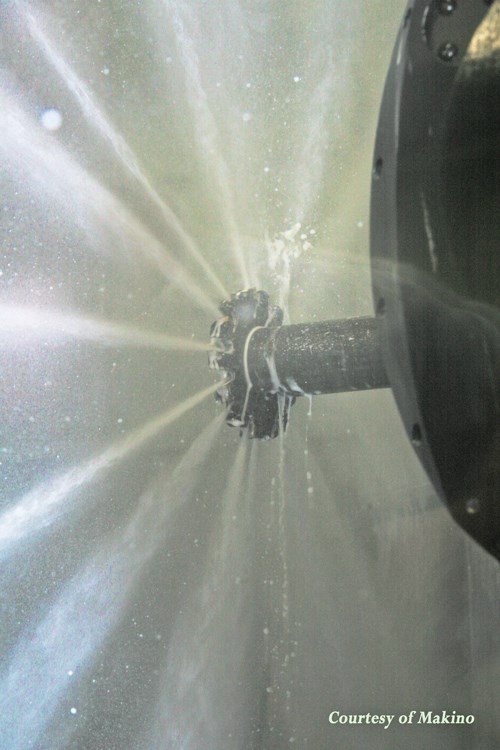Considerations for Machining Exotics
In manufacturing, the term “exotic” is used to describe materials that display excellent wear characteristics, durability and service life in high heat, extreme cold or corrosive environments.
#metalworkingfluids
In manufacturing, the term “exotic” is used to describe materials that display excellent wear characteristics, durability and service life in high heat, extreme cold or corrosive environments. These materials were designed to fill a niche or service for which standard materials are not able to perform. Exotic metals include titanium, Waspaloy, Inconel, Hastelloy, Kovar, Invar and Monel. Non-metals include glass-filled plastics or phenolics, Kevlar, machinable glass and machinable carbide.
Exotic materials can have 20 percent machinability of carbon steel. Cutting, stamping and forming is possible when preformed at the correct speeds and feeds. But that’s only part of the story. Each material presents potential problems of their own that can blow conventional machining practices out the window. Or do they?
Featured Content
Because of a lack of knowledge about the best approach for machining exotics, most shops, understandably, will not even quote these jobs. However, with the internet, list serves (such as those available to PMPA members) and blogs, along with the extensive number of tooling experts, material vendors and tribologists, plenty of information is available that was not so easily accessible only a few years ago. If information is the only obstacle, we can dare say that’s gone.
So why do contract manufacturers shy away from machining exotics? Experience (or lack of) and up-front costs are usually the driving forces. The need to purchase the material in the correct condition to eliminate the need for excess machining could result in doubling tooling costs and halving speeds and feeds. It all starts at the quoting stage. And shops must be prepared; with so few shops quoting exotic work, the odds of landing the job are good.
The Best Approach
When a shop commits to working with exotics, it must be prepared for some adjustments to its conventional processes. Can the shop equipment handle the increase in material tensile strength or cutting forces? Will shop tooling, adapters and measuring equipment be appropriate?
Fixturing must be built to compensate for the higher forces. It might be a gradual transition as the shop slowly learns how the equipment responds to these increased cutting forces. Negative verses positive tooling forces can stall a light-duty machine even in small-diameter end mills. Chatter can become a big problem with light-duty tooling and machines. Slotting with a half-inch, two-flute end mill ¼-inch deep in Kovar can stall a 7-hp spindle. Getting good quality adapters and cutting toolholders is very important. Lubrication through the tool and at least 300 psi could increase tool life 20-fold.
Another important consideration is the personnel that will run the job. Most shops give the job to their best operator and hope for the best, and whatever experience is gained from the job remains in the head of that single operator. Yes, it’s important to use qualified people, but it’s also important to teach all involved what is expected, including inspection requirements.
If insert usage increases drastically, the operator in charge will need to answer to the manager. But when tools were only lasting four parts and now they’re down to three, who will notice? Well documented tool life sheets may show patterns that a roughing tool is being used too long, resulting in excess finish tool failure. It may be better to change to lighter cuts at higher speeds and feeds, or the opposite. Using the 15-degree side of the 80-degree diamond could make the roughing almost free. Adjusting the tool speeds and feeds to extend the tool life can be wasteful and expensive. Calculating and tracking the tool usage cost per part is very important.
Most exotic metals produce a bright finish using minimally sharp tooling, but this surface may be work hardened and not acceptable to the customer. Teaching the operator and inspector to check surface finish and providing pictures can help.
When measuring a part, it’s important to check not only diameters, but square shoulders or walls, as well. With most materials, the rule of thumb is that once the machine is set up, the depth of steps is fixed as long as the same tool is doing both or multiple steps. Some of the exotics can push a tool away and cause an out-of-square step, even if it cuts all of the surfaces. A 35-degree diamond will push away when turning a diameter to a shoulder, then up that shoulder to another diameter. If the roughing tool leaves too much material, the insert might not cut a square shoulder.
Lessons Learned
One challenging part demonstrated the effects of work hardening. A bearing housing had a Babbitt bearing preparation groove—0.625-inch diameter by 1.1-inches by 0.250-inch wide groove in 321 stainless steel. Subtracting the groove depth from the bore diameter resulted in a tool shank of 0.380 inch. Getting enough oil or coolant into the cut to remove the chips was a difficult challenge. The 321 stainless would work harden if the rough tool got dull, making the finishing operation almost impossible. So the best practice was to rough out the part, then cut the groove in a separate operation running simultaneously on another machine.
The best grooving tool was 8 percent cobalt high speed steel running at 50 sfm. Two tools were made to rough and finish 300 parts. Once the proper grinding process was finally established, two dedicated oil lines were installed to blow the chips out of the hole and keep the material cool. It was a painful lesson learned.
Another challenging part is a blood filtering insert with a 0.018-inch diameter hole in R-Monel. Prevention of burrs was vital, as they will injure white blood cells. The part has a 0.125-inch diameter hole to a 60-degree included cone bottom down to the 0.018-inch diameter hole. The part had to seal with a few ounces of pressure. The 60-degree cone makes an impression on the first cycle, but the second cycle often does not seal if the cone finish is not clean enough. It took a couple of burnishing tools to produce a part that worked. The good tool produced more than 300 parts before it needed to be dressed. The previous failure rate was 20 percent, but with the right tool, the failure rate dropped to zero. A good 20-power microscope was the key in seeing what needed to be fixed.
Excelling in Exotics
Tooling, machine and lubricant technical salespeople have seen shops cutting exotics. They know it works, and many times these sales personnel save the best technology for those shops that will let them partner, helping everyone involved. When a factory tech gets to showcase his best technology, both sides win. As any shop will do its best for its good customers, so in turn, the factory techs will do their best for their best customers. These potential partners should be interviewed to determine who has the most experience and who can be most trusted with the job. Tough, subtle questions can help determine the level of knowledge. Trusted suppliers will share their success and valuable knowledge, which will lead to improvements.
Once a shop has mastered these exotic materials, potential competitors are limited. Shop rates will go up considerably, along with potential profits. Customers know the cost and need for expertise when looking for suppliers that can deliver successfully. Sometimes it can take months to get material; depending on a new, unproven supplier can put delivery even more at risk. When a shop establishes itself as an expert with one or more of these materials, it can lock in a solid customer base, and in the end, the experience gained will improve even the easiest jobs.
— Hangsterfer’s Laboratories Inc.
RELATED CONTENT
-
What’s Ahead for the U.S. Metalworking Economy?
Although previously robust, the U.S. metalworking economy has softened in recent months. However, the overall outlook remains strong. Even a possible 2023 recession does not appear to be an obstacle to continued growth over the next few years.
-
Consistency with Indirect Extrusion
A return to basics, paired with extensive research, proved instrumental in the enhancements of this aluminum rod and bar manufacturer’s product line.
-
How Metallurgical Structure Affects the Machinability of Aluminum
Advancements in grain structure consistency and mechanical properties help to make this extremely machinable metal suitable for an ever growing range of applications.








